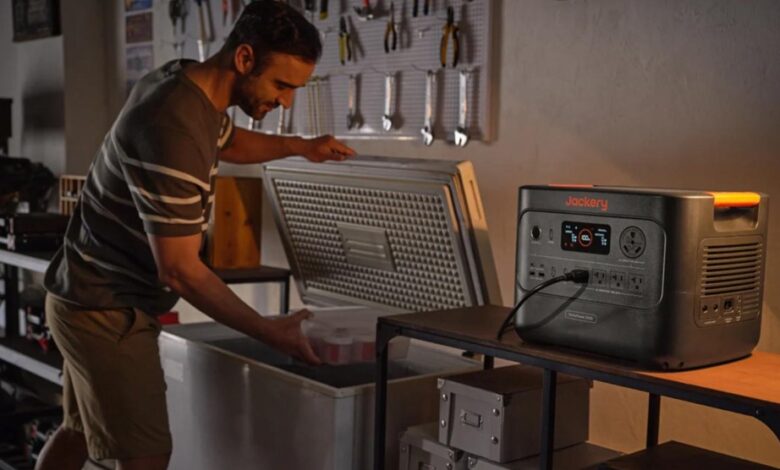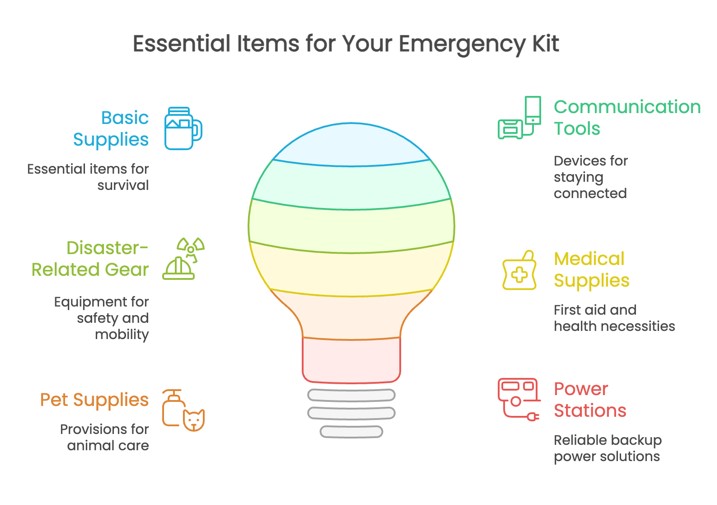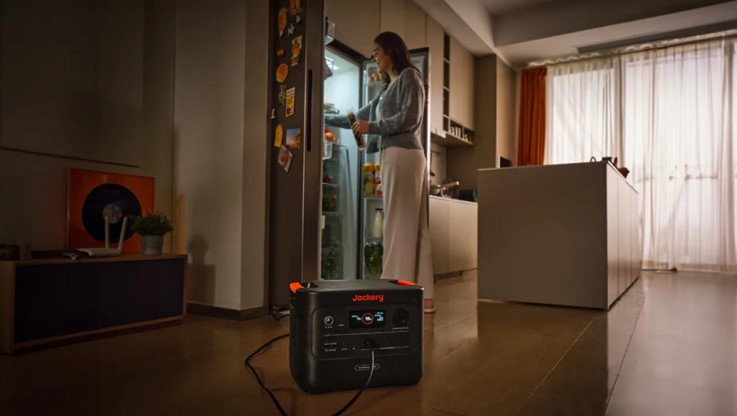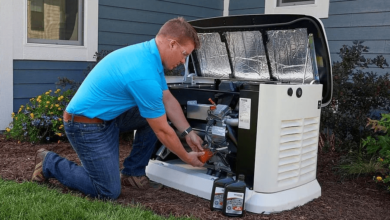Emergency Kits for Home: How to Prepare for Hurricane Season

The United States is currently in the middle of hurricane season, a time when severe storms can develop quickly and leave people in uncertainty. During this season, storms can cause widespread power outages, flooding, and major disruptions with little warning. This is why every household should have a fully prepared emergency kit for the home in place. A well-equipped kit provides stability during hurricanes, floods, and power failures, helping families stay safe, informed, and connected. Jackery emergency home backup power stations provide reliable electricity, so that you won’t have to worry about the power outages that have become a new normal during natural disasters.
What are the risks associated with the hurricane season, and how can to prepare for it? Let’s see:
Risks During Hurricane Season
Hurricanes bring a wide range of hazards that can severely disrupt essential services and daily life. Among the most immediate threats is power loss. High winds frequently damage power lines and substations, resulting in widespread outages. During Hurricane Beryl in July 2024, more than 2.7 million homes and businesses across the Houston area lost electricity. The extended outage, combined with extreme heat, led to several heat-related fatalities and placed significant pressure on emergency services.[1]
When power is unavailable, critical needs such as communication, refrigeration, and medical care are quickly affected.
Flooding is another serious risk associated with the hurricane season. Storm surges and heavy rainfall can overwhelm drainage systems, damage structures, and block entire roads. In September 2024, Hurricane Helene caused severe flooding and landslides across North Carolina, damaging bridges and isolating entire communities. The damage to infrastructure not only delayed rescue operations but also restricted access to essential supplies and medical assistance.[2]
When communication networks collapse, the situation becomes even more difficult to manage. Mobile phone towers and internet infrastructure become vulnerable during large storms. In past events, such as Hurricane Maria in 2017, many residents were left without access to emergency updates or the ability to contact family members.[3]
A lack of reliable communication during an emergency can increase confusion and impact your ability to make critical decisions.
The damage to public infrastructure, including transportation, utilities, and healthcare systems, often takes weeks to repair. Disruptions in these areas can significantly limit access to fuel, clean water, and medical care, especially in communities with fewer resources. In the absence of publicly available resources, residents often rely heavily on personal preparedness to get out of trouble.
Given these risks, reliable backup power and a well-structured emergency plan are essential. Hurricanes are becoming stronger and less predictable. Households that invest in emergency kits for homes and proactive planning are in a far better position to remain safe, maintain vital routines, and recover with less disruption.
Essential Items for Your Emergency Kit
When a hurricane disrupts daily life, immediate access to supplies is often limited. Shelves empty quickly, stores may close for extended periods, and transportation networks can be blocked. That is why you need a home emergency survival kit that covers different types of needs.
1. Basic Supplies
Water is one of the most important things to store while preparing for hurricane emergencies. Store at least one gallon per person per day, with a three-day minimum supply. Storing non-perishable food items is equally important. Choose ready-to-eat items that require no refrigeration or cooking, such as canned goods, granola bars, and shelf-stable meals. A full first-aid emergency supply kit for home is essential for treating minor injuries when medical services may not be immediately available. Include a reliable flashlight, spare batteries, and hygiene items like soap, hand sanitizer, moist towelettes, toothbrushes, and feminine care products. These supplies reduce the risk of illness and help maintain basic hygiene when running water or electricity is not available.
2. Communication Tools
Staying informed during a power outage requires independent communication tools. A battery-powered or hand-crank radio provides access to emergency alerts, weather reports, and government announcements. Backup phone chargers are also necessary. Jackery portable power stations are a practical solution for these emergencies, offering dependable power for phones and other small electronics. These devices help maintain contact with emergency services and loved ones when the grid is down.
3. Disaster-Related Gear
In disaster situations, certain items can improve safety and mobility. Include an emergency whistle for signaling rescue personnel, especially if you risk being trapped or isolated. Dust masks protect against poor air quality caused by mold, smoke, or debris. Sturdy gloves are important for handling broken objects or clearing paths. A compact rain poncho protects against severe weather during evacuations or outdoor movements. Even in short-term emergencies, having these tools available can help prevent injury and make relocation safer and more manageable.
4. Medical Supplies
Include a sufficient supply of prescription medications, over-the-counter pain relievers, allergy treatments, and any necessary medical equipment. For families with infants or elderly members, pack baby formula, diapers, or assistive care items such as walkers or battery-powered medical devices. Access to pharmacies and delivery services may be cut off during an emergency, so advance preparation is critical. If someone in the home requires refrigerated medication, a portable power source becomes essential to ensure a power supply and medicine protection.
5. Pet Supplies
For pets, set aside extra pet food, medications, water, and feeding containers. Include items that provide comfort, such as a familiar toy or blanket. If evacuation becomes necessary, having a pet carrier and leash on hand is also important. Planning ahead for pets ensures their safety and avoids unnecessary complications during an evacuation.
Once all supplies are gathered, how they are stored also plays an important role when the emergency strikes. Use a durable, waterproof container with a secure lid to keep items protected. Label sections clearly, so you can access essentials quickly under stress. For larger households, consider preparing multiple emergency kits for home placed in key locations like the car, garage, or hallway. Regularly check batteries, medication expiry dates, and seasonal needs, and adjust the emergency kits for home accordingly.

How a Power Station Can Play a Vital Role in Your Emergency Kit
Power outages are one of the first and most widespread consequences of a hurricane. When the grid fails, it affects everything from lighting and communication to food storage and critical medical care. In such moments, a reliable power backup becomes a necessity. This is where Jackery portable power stations come in.
They offer dependable power solutions that allow you to keep essential devices running when traditional power sources are unavailable. These portable stations can charge phones, power flashlights, run small refrigerators, and even support critical medical equipment such as CPAP machines. This capability becomes especially important when outages last longer than expected and when vulnerable household members rely on powered health devices.
In households with multiple people relying on shared power access, having a portable station that supports simultaneous charging becomes a game-changer. Jackery units allow multiple devices to be powered at once without overloading the system.
Jackery emergency kits for home are compact, easy to store, and simple to operate. Unlike fuel-based generators, they produce no fumes, operate quietly, and can be used safely indoors. These units are also solar-compatible, which means you can recharge them during extended outages without relying on the grid or fuel supply chains.
In the context of emergency preparedness, Jackery portable power stations offer a practical and flexible solution. They help you maintain communication, preserve essential food and medicine, and stay safe and functional when everything else around you is disrupted.
Jackery Recommendation
Jackery offers multiple emergency kits for homes that will help you navigate the troubles associated with hurricane emergencies.
Let’s have a look at these options one by one:
1. Jackery Explorer 1000 v2 Portable Power Station
This is a highly compact yet powerful energy generator that generates reliable electricity for covering essential devices during short to mid-length power outages. It offers 1070Wh of storage capacity with a 1500W rated output and 3000W surge power, which makes it ideal for powering devices like a refrigerator, microwave, Wi-Fi router, or desktop computer for several hours.
The Jackery Explorer 1000v2 Portable Power Station includes multiple output options, including USB-A, USB-C (up to 100W), and AC outlets that allow you to operate multiple appliances simultaneously.
It also features emergency fast charging, allowing it to reach full charge in just one hour through AC input. The unit integrates Jackery’s ChargeShield 2.0, offering over 60 layers of safety protection, and supports UPS functionality, which enables seamless transition to backup power without interruption. This UPS functionality is critical for devices like computers or medical equipment in case of sudden power outages.
This power station weighs just over 24 pounds and is designed with a foldable handle. It is easy to transport or store in tight spaces, which further increases its appeal.
2. Jackery Explorer 2000 v2 Portable Power Station
If your households require higher output and longer runtimes, the Jackery Explorer 2000 v2 Portable Power Station provides 2042Wh of capacity and supports up to 2200W of continuous output. Just like the Jackery Explorer 1000v2 Portable Power Station, this power station is also built with advanced LiFePO₄ battery technology, which makes it usable for more than 10 years, even with daily use.
The Jackery Explorer 2000 v2 Portable Power Station is engineered with Jackery’s Cell-To-Body (CTB) structure, allowing for a 40% smaller and 34% lighter footprint compared to similar-capacity power stations. It can keep on powering your heavy appliances while generating noises as low as 30 decibels.
This power station comes with four charging methods, including AC, solar, car, and gas generator, with emergency charging completed in just 1.7 hours. The device also includes a smart app for real-time power monitoring and control, and an integrated UPS system that protects devices from unexpected shutdowns. This unit can handle refrigerators, lighting systems, computers, medical devices, and even cooking appliances, providing dependable backup for more demanding home setups.
During multi-day outages, the Jackery Explorer 2000 v2 Portable Power Station can run a refrigerator for an entire day, recharge mobile devices repeatedly, and keep essential lighting on through the night. It is particularly useful in areas where utility repair times are slow or in remote homes that experience seasonal storms more frequently.
3. Jackery HomePower 3000
When you are expecting long power outages and a full-home power continuity is a priority, the Jackery HomePower 3000 is the best emergency solar generator for home. This unit provides 3072Wh of storage and a 3600W output (with a 7200W surge), enough to support major appliances and multiple devices simultaneously.
This power station comes with the innovative ZeroDrain™ technology, which helps it retain up to 95% of its charge for one year, empowering you for long-term emergency readiness. The Jackery HomePower 3000 features multiple output ports, including USB-C, USB-A, and AC, which allows you to support multiple power-hungry devices such as refrigerators, air purifiers, CPAP machines, fans, and even high-wattage electronics like induction cooktops, at the same time.
Like other Jackery portable energy solutions, this power station also comes with flexible charging options. From a traditional AC outlet, you can recharge it in almost 2.2 hours, while a combination of AC and DC charging takes almost 1.7 hours. When charged through two 200W solar panels, it completely recharges in just 11 hours.
The integrated UPS ensures seamless power switching under 20 milliseconds, minimizing interruptions during outages. It is also the lightest and most compact 3kWh LFP generator on the market, offering high capacity without adding any unnecessary bulk.

Wrapping-Up
Hurricane season brings unpredictable conditions that can disrupt daily life without warning. Having well-prepared home emergency kits becomes a game-changer in these situations. From food and medical supplies to reliable backup power, each item plays a critical role in protecting your home and keeping your family safe during an extended outage. Jackery’s portable power solutions add a vital layer of security to any emergency kit. Their ability to support essential devices, offer clean indoor-safe energy, and recharge through multiple methods makes them an ideal choice for hurricane preparedness.



